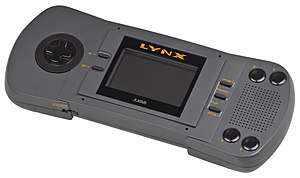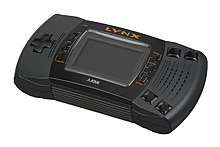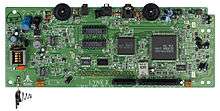Atari Lynx
The Atari Lynx is a 8/16-bit handheld game console that was released by Atari Corporation in September 1989 in North America, and in Europe and Japan in 1990.
 Atari Lynx I | |
| Developer | |
|---|---|
| Manufacturer | Atari Corporation |
| Type | Handheld game console |
| Generation | Fourth generation |
| Release date | September 1, 1989 |
| Lifespan | 1989–1995 |
| Introductory price | US$179.99[1] |
| Units sold | Around 3 million |
| Media | ROM cartridge |
| CPU | "Mikey" (WDC 65SC02 8-bit CPU + Sound processor + LCD driver) |
| Display | 160 × 102 standard resolution (16,320 addressable pixels) |
| Graphics | "Suzy" (16-bit custom CMOS) |
It was the world's first handheld electronic game with a color LCD. It was also notable for its advanced graphics and ambidextrous layout. The Lynx competed with the Game Boy (released two months earlier), as well as the Game Gear and TurboExpress, both released the following year. It was discontinued in 1995.
History
The Lynx system was originally developed by Epyx as the Handy Game. In 1986, two former Amiga designers, R. J. Mical and Dave Needle, had been asked by former manager at Amiga, David Morse, if they could come up with a design for a portable gaming system.[2][3] Morse now worked at Epyx, a game software company that had a recent string of hit games. Morse's son had asked him if he could make a portable gaming system, prompting a meeting with Mical and Needle to discuss the idea. Morse convinced Mical and Needle to develop the idea and they were hired by Epyx to be a part of the design team.[2] Planning and design of the console began in 1986 and was completed in 1987.[4] Epyx first showed the Handy system at the Winter Consumer Electronics Show (CES) in January 1989.[2] Facing financial difficulties, Epyx sought out partners. Nintendo, Sega, and other companies declined, but Atari and Epyx eventually agreed that Atari would handle production and marketing, while Epyx would handle software development. Epyx declared bankruptcy by the end of the year, and Atari essentially owned the entire project; both Atari and others, however, had to purchase Amigas from Atari archrival Commodore to develop Lynx software.[5]
The Handy was designed to run games from the cartridge format, and the game data must be copied from ROM to RAM before it can be used. Thus, less RAM is then available and each game's initial loading is slow.[6] There are trace remnants of a cassette tape interface physically capable of being programmed to read a tape. Lynx developers have noted that "there is still reference of the tape and some hardware addresses"[7] and an updated vintage Epyx manual describes the bare existence of what could be utilized for tape support.[8]:ch.2,8 A 2009 retrospective interview clarifies that although some early reports claimed that games were loaded from tape, Mical says there was no truth in them: "We did think about hard disk a little."[9]
Atari changed the internal speaker and removed the thumb-stick on the control pad before releasing it as the Lynx, initially retailing in the US at US$179.95. Atari then showed the Lynx to the press at the Summer 1989 CES as the "Portable Color Entertainment System", which was changed to "Lynx" when actual consoles were distributed to resellers.[6]
The Lynx started off successfully. Atari reported that they had sold 90% of the 50,000 units it shipped in its launch month in the U.S. with a limited launch in New York.[10] US sales in 1990 were approximately 500,000 units according to the Associated Press.[11] In late 1991, it was reported that Atari sales estimates were about 800,000, which Atari claimed was within their expected projections.[12] Lifetime sales by 1995 amounted to fewer than 7 million units when combined with the Game Gear.[13] In comparison, the Game Boy sold 16 million units by 1995[13] because it was more rugged, cost half as much, had much longer battery life, was bundled with Tetris, and had a superior software library.[5]
As with the actual console units, the game cartridges themselves evolved over the first year of the console's release. The first generation of cartridges were flat, and were designed to be stackable for ease of storage. However, this design proved to be very difficult to remove from the console and was replaced by a second design. This style, called "tabbed" or "ridged", used the same basic design as the original cartridges with the addition of two small tabs on the cartridge's underside to aid in removal. The original flat style cartridges could be stacked on top of the newer cartridges, but the newer cartridges could not be easily stacked on each other, nor were they stored easily. Thus a third style, the "curved lip" style was produced, and all official and third-party cartridges during the console's lifespan were released (or re-released) using this style.[14]
In May 1991, Sega launched its Game Gear portable gaming handheld. Also a color handheld, in comparison to the Lynx it had a higher cost and shorter battery life (3–4 hours as opposed to 4-5 for the Lynx), but it was slightly smaller and was backed up by significantly more games.
Retailers such as Game and Toys R Us continued to sell the Lynx well into the mid-1990s on the back of the Atari Jaguar launch, helped by magazines such as Ultimate Future Games who continued to cover the Lynx alongside the new generation of 32-bit and 64-bit consoles.
Lynx II

During 1990, the Lynx had moderate sales. In July 1991, Atari introduced the Lynx II with a new marketing campaign, new packaging, slightly improved hardware, better battery life and a new sleeker look. The new system (referred to within Atari as the "Lynx II") featured rubber hand grips and a clearer backlit color screen with a power save option (which turned off the LCD panel's backlighting). It also replaced the monaural headphone jack of the original Lynx with one wired for stereo. The new packaging made the Lynx available without any accessories, dropping the price to $99. Although sales improved, Nintendo still dominated the handheld market.
Decline
In 1993, Atari started shifting its focus away from the Lynx in order to prepare for the launch of the Jaguar. A few games were released during this time, including Battlezone 2000. Support for the Lynx would not be formally discontinued until 1995. After the launch of the Sega Saturn and Sony PlayStation drastically caused the commercial failure of the Jaguar that same year, Atari terminated all internal game and hardware development and, in 1996, agreed to reverse merge with JTS, Inc., thus the Atari brand would leave the gaming market for good; the Atari properties were soon sold to Hasbro Interactive in 1998.[15]
Features
.jpg)
The Atari Lynx's innovative features include being the first color handheld, with a backlit display, a switchable right-handed/left-handed (upside down) configuration, and the ability to network with up to 15 other units via its Comlynx system (though most games would network eight or fewer players). Comlynx was originally developed to run over infrared links (and was codenamed RedEye).[16] This was changed to a cable-based networking system before the final release. According to Peter Engelbrite, when players walked through the beam, the link would be interrupted. The maximum stable connection allowed was eight players.[16] Engelbrite also developed the first recordable eight-player co-op game, and the only eight-player game for the Atari Lynx, Todd's Adventures in Slime World, using the Comlynx system. Each Lynx needed a copy of the game, and one cable could connect two machines. The cables could be connected into a chain.
Dave Needle, Lynx co-designer[9]
The Lynx was cited as the "first gaming console with hardware support for zooming and distortion of sprites". Featuring a 4096 color palette and integrated math and graphics co-processors (including a blitter unit), its pseudo-3D color graphics display was said to be the key defining feature in the system's competition against Nintendo's monochromatic Game Boy. The fast pseudo-3D graphics features were made possible on a minimal hardware system by co-designer Dave Needle having "invented the technique for planar expansion/shrinking capability" and using stretched, textured, triangles instead of full polygons.[9]
Technical specifications


- Mikey (8-bit custom CMOS chip running at 16 MHz)[17]
- WDC 8-bit 65SC02 processor (based on the MOS 6502) running at up to 4 MHz (3.6 MHz average)[2]
- Sound engine
- 4 channel sound
- 8-bit DAC for each channel (4 channels × 8-bits/channel = 32 bits commonly quoted) these 4 sound channels can also switch in analogue sound mode to generate PSG sound . Atari reports the range is "100 Hz to above the range of human hearing"; spectrum analysis shows the range may go as low as 32 Hz.
- Stereo with panning (Lynx II PAG-0401 only, original Lynx and early Lynx II are mono)
- Video DMA driver for liquid-crystal display
- Custom built and designed by Jay Miner and David Morse[18]
- 160×102 pixels resolution
- 4,096 color (12-bit) palette
- 16 simultaneous colors (4 bits) from palette per scanline
- Variable frame rate (up to 75 frames/second)
- 8 System timers (2 reserved for LCD timing, one for UART)
- Interrupt controller
- UART (for Comlynx) (fixed format 8E1, up to 62500 Bd)
- 512 bytes of bootstrap and game-card loading ROM
- Suzy (16-bit custom CMOS chip running at 16 MHz)
- Unlimited number of blitter "sprites" with collision detection
- Hardware sprite scaling, distortion, and tilting effects
- Hardware decoding of compressed sprite data
- Hardware clipping and multi-directional scrolling
- Math engine
- Hardware 16-bit × 16-bit → 32-bit multiply with optional accumulation; 32-bit ÷ 16-bit → 16-bit divide
- Parallel processing of CPU
- RAM: 64 KB 120ns DRAM
- Cartridges of 128, 256, 512KiB and (with bank-switching) 1MiB
- Ports:
- Headphone port (3.5 mm stereo; wired for mono on the original Lynx)
- ComLynx (multiple unit communications, serial)
- LCD Screen: 3.5" diagonal
- Battery holder (six AA) 4–5 hours (Lynx I) 5–6 hours (Lynx II)
Reception
The game system was reviewed in 1990 in Dragon, which gave the Lynx 5 out of 5 stars. The review states that the Lynx "throws the Gameboy [sic] into the prehistoric age", and praises the built-in object scaling capabilities, the multiplayer feature of the ComLynx cable, and the strong set of launch games.[19]
The infrequency of Lynx software releases and the system's minimal marketing budget have been cited as the main factors in its commercial failure.[20]
Legacy
Telegames released a number of games in the second half of the 1990s, including a port of Raiden and a platformer called Fat Bobby in 1997,[21] as well as an action sports game called Hyperdrome in 1999.
In 1999, Hasbro, which would continue to hold on to the Atari properties until 2000, released all development rights on the Lynx, as well as all patents relating to the Jaguar, into the public domain,[22] and thus the two platforms were declared open to everyone.
In 2008, Atari was honored at the 59th Annual Technology & Engineering Emmy Awards for pioneering the development of handheld games with its Lynx game unit.[23]
Lynx games by independent developers include T-Tris (the first Lynx game with save-game feature),[24] Alpine Games,[25] and Zaku.[26]
See also
References
- "Toys R Us weekly ad". The Catoosa County News. December 5, 1990. Retrieved June 17, 2014.
- Jermaine, John (November 1989). "Lynx, an interview with the men behind the machine". Electronic Gaming Monthly. United States: Sendai Publications. Archived from the original on September 16, 2014. Retrieved June 17, 2014.
- Jacobs, Steven. "Third Time's a Charm (They Hope)". Wired. United States: Conde Nast. Retrieved June 17, 2014.
- Peter Latimer (July 2005). "Atari Lynx". Retro Gamer (4): Pages 24–31. ISSN 1742-3155.
- Maher, Jimmy (December 22, 2016). "A Time of Endings, Part 2: Epyx". The Digital Antiquarian.
- Peter Latimer (July 2005). "Atari Lynx". Retro Gamer. 2 (6): Pages 24–31. ISSN 1742-3155.
- "Atari Lynx programming tutorial series". Diary of an Atari Lynx developer. Retrieved June 18, 2014.
- "Lynx Hardware Overview". Epyx. 1987. Retrieved June 18, 2014.
- "Retroinspection: Atari Lynx". NOW Gamer. January 22, 2009. Archived from the original on February 5, 2013. Retrieved June 18, 2014.
- "New games make big splash". The Nevada Daily Mail. Vernon County, Missouri. June 3, 1990. Retrieved June 17, 2014.
- Catalina Ortiz (January 4, 1991). "Sega Woos Game Boy, Lynx Users With 32-Color, Hand-Held Video System" (Press release). Associated Press. Retrieved November 7, 2013.
- "Raze Magazine" (11). September 1991: 6. Cite journal requires
|journal=(help) - Steven Kent (January 5, 1995). "Virtual Fun - Nintendo Adds A New Dimension To Games". Seattle Times. Retrieved November 7, 2013.
- Atari Lynx cartridge style illustrations at AtariAge.com.
- Johnston, Chris (April 28, 2000). "Atari goes to Hasbro". GameSpot.
- "Todd's Adventures in Slime World". Retro Gamer Magazine (164): 74.
- "Atari Lynx FAQ". AtariAge. atariage.com. Retrieved October 24, 2014.
- "Nintendo's island state of a stand at the Consumer Electronics Show in Chicago couldn't stop Atari stealing the limelight with their amazing hand-held video game machine". ACE Magazine. August 1989. p. 26. Retrieved August 11, 2018 – via archive.org.
- Lesser, Hartley; Lesser, Patricia; Lesser, Kirk (March 1990). "The Role of Computers". Dragon (155): 95–101.
- "The Next Generation 1996 Lexicon A to Z: Lynx". Next Generation. No. 15. Imagine Media. March 1996. p. 36.
- "News Bits". GamePro. No. 105. IDG. June 1997. p. 20.
- "Retro Isle - Atari Lynx". www.retroisle.com. Retrieved September 9, 2018.
- "CES '08: Nintendo wins second Emmy". GameSpot. January 8, 2008. Retrieved May 9, 2014.
- "LYNX: T-Tris".
- Duranik. "Duranik". Retrieved February 13, 2015.
- Brandon Cobb. "Zaku - www.zaku-lynx.com". Archived from the original on May 15, 2017. Retrieved February 13, 2015.
External links
| Wikimedia Commons has media related to Lynx (console). |